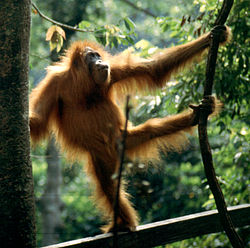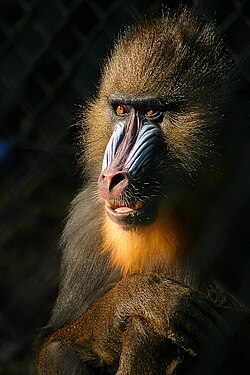Portal:Primates Source: en.wikipedia.org/wiki/Portal:Primates
The Primates Portal A primate is a member of the biological order Primates, the group that contains lemurs, the aye-aye, lorisids, galagos, tarsiers, monkeys, and apes, with the last category including great apes. With the exception of humans, who inhabit every continent on Earth, most primates live in tropical or subtropical regions of the Americas, Africa and Asia. Primates range in size from the 30-gram (1 oz) pygmy mouse lemur to the 200-kilogram (440 lb) mountain gorilla. According to fossil evidence, the primitive ancestors of primates may have existed in the late Cretaceous period around 65 mya (million years ago), and the oldest known primate is the Late Paleocene Plesiadapis, c. 55–58 mya. Molecular clock studies suggest that the primate branch may be even older, originating in the mid-Cretaceous period around 85 mya. Primates exhibit a wide range of characteristics. Some primates do not live primarily in trees, but all species possess adaptations for climbing trees. Locomotion techniques used include leaping from tree to tree, walking on two or four limbs, knuckle-walking, and swinging between branches of trees (known as brachiation). Primates are characterized by their large brains relative to other mammals. These features are most significant in monkeys and apes, and noticeably less so in lorises and lemurs. Many species are sexually dimorphic, which means males and females have different physical traits, including body mass, canine tooth size, and coloration.
Selected article
Fork-marked lemurs or fork-crowned lemurs are nocturnal strepsirrhine primates, with four species comprising the genus Phaner. Like all other lemurs, they are native to Madagascar. They are named for the two black stripes which run up from their eyes, converge on the top of their head, and run down the back as a single black stripe. Only one species (Phaner furcifer) was recognized until three new subspecies—described in 1991—were promoted to species status in 2001. New species may yet be identified, particularly in northeast Madagascar.
Fork-marked lemurs are among the least studied of all lemurs and are some of the largest members of the family Cheirogaleidae, weighing around 350 grams (0.77 lb) or more. Aside from their dorsal forked stripe, they have dark rings around their eyes, and large membranous ears. Males have a scent gland on their throat, but only use it during social grooming, not for marking territory. Instead, they are very vocal, making repeated calls at the beginning and end of the night. Males usually pair up with females to form monogamous pairs, and females are dominant. They sleep in tree holes and nests. Females are thought to have only one offspring every two years or more. They live in a wide variety of habitats, ranging from dry deciduous forests to rainforests and run quadrupedally across branches. Their diet consists primarily of tree gum and other exudates, though they may also hunt small arthropods later at night. Three of the four species are endangered and the other is listed as vulnerable. Their populations are in decline due to habitat destruction. Like all other lemurs, they are protected against commercial trade under CITES Appendix I. Selected picture The mandrill is the world's largest species of monkey. The word mandrill means "man-ape" according to the Oxford English Dictionary. CategoriesSelected species Vulnerable (IUCN 3.1)|Vulnerable The Central American squirrel monkey (Saimiri oerstedii) is a squirrel monkey species from the Pacific coast of Costa Rica and Panama. It is a small monkey with an orange back and a distinctive white and black facial mask. It has an omnivorous diet, eating fruits, other plant materials, invertebrates and some small vertebrates. In turn, it has a number of predators, including raptors, cats and snakes. It lives in large groups that typically contain between 20 and 75 monkeys. It has one of the most egalitarian social structures of all monkeys. Females do not form dominance hierarchies, and males only do so at breeding season. Females become sexually mature at 2½ years, and males at 4 to 5 years. Sexually mature females leave the natal group, but males can remain with their natal group their entire life. The Central American squirrel monkey can live for more than 15 years. Did you know?
Primate lists
WikiProjectsThings to do
Associated WikimediaDiscover Wikipedia using portals
|
















